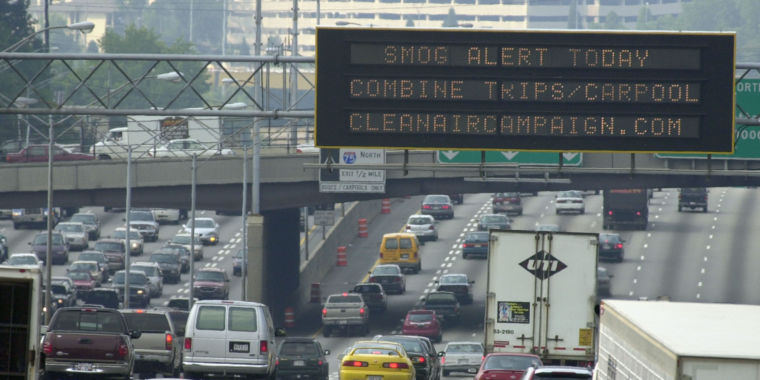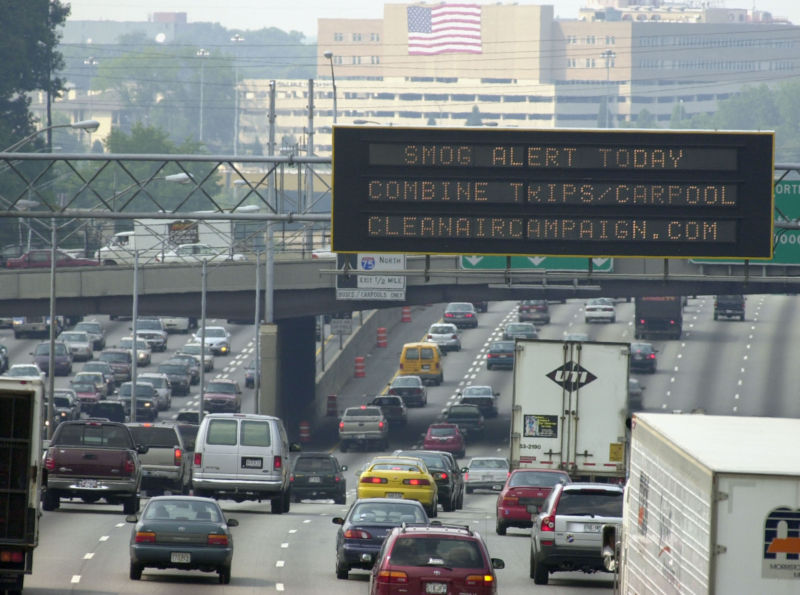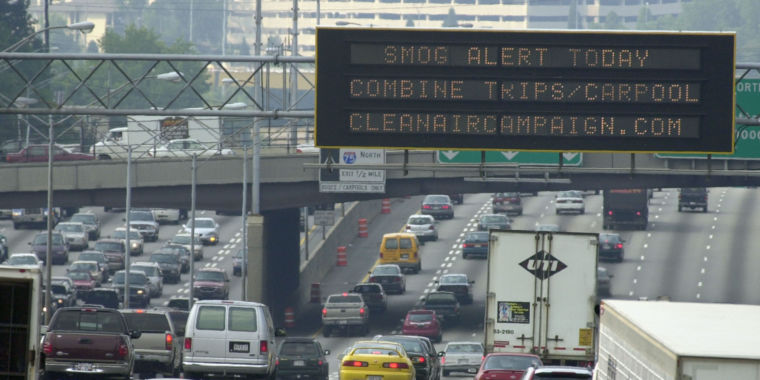
carbon conflict —
Appointees assert that higher fuel-economy standards would cause more deaths.

Enlarge / Cars and trucks drive along Interstate 75/85 June 25, 2003 in Atlanta, Georgia.
The Trump administration has been trying to roll back Obama-era fuel-economy standards for passenger vehicles out to model year 2025. But the state of California and its allies have been fighting this rollback in every venue possible.
Today, energy and commerce subcommittees from the House of Representatives held a joint hearing to question the creators of the proposed fuel-economy-standards rollback. William Wehrum, the Assistant Administrator in the Office of Air and Radiation at the Environmental Protection Agency (EPA), and Heidi King, the Deputy Administrator at the National Highway Traffic Safety Administration (NHTSA), both responded to questions from representatives on how the two agencies came to propose the new fuel-economy rollback.
Later in the day, a second panel included Mary Nichols, the chairperson of the California Air Resource Board (CARB), which has been the leader of the fight against a fuel economy rollback.
During the first half of the hearing, much of the questioning was focused on Wehrum, given that the EPA has a stronger mandate to regulate emissions, whereas the NHTSA is focused primarily on highway safety.
A tangled web of models
The proposed rollback, which was announced last summer, would hold fuel-economy standards fixed after 2020, rather than requiring automakers to meet more and more stringent emissions standards for the next five years. The EPA justified this at the time by saying that requiring automakers to meet more stringent standards would increase the price of new vehicles in the US and more expensive new vehicles would mean that fewer people would buy new vehicles. This means that drivers would stay in older and less-safe vehicles, causing the number of road fatalities to increase.
Scientists and researchers have disputed this reasoning vigorously, noting that research has not been able to show a link between fatalities and more rigorous fuel-economy standards, the cost to build a vehicle does not always clearly translate to the price of the vehicle, and the cost/benefit analysis that the EPA made public appears to rely on inherently flawed assumptions about the number of cars on the road and how many miles individuals will drive with more-efficient cars.
During the hearing, Wehrum and King defended the assumptions made by the two agencies in their 2018 assessment. Wehrum told the committee that the EPA largely depended on the NHTSA’s vehicle-fleet forecasting model, which assumes that people drive 20 percent more for every incremental gain in fuel efficiency. This assumption, called the “rebound effect,” has been verified by research, but a 20 percent rebound effect as an average across the country is disputed by academics. The EPA’s model, by contrast, assumes a 10 percent rebound effect.
However, Wehrum said that “A decision was made early on that we would rely on a single model,” and the EPA went with the NHTSA model. Although Wehrum and King went into very little detail about the differences between the respective models, using a model with a higher rebound effect might show that increased fuel economy would lead to more driving and, therefore, weaker emissions reductions and higher on-road fatalities.
King also told the representatives that the NHTSA reevaluated the Obama-era rule because markets had changed so dramatically since the rules were first proposed in 2012. “There has been a change in the fuel position of the United States, and that has manifested a change in fuel prices,” King said. She noted that fuel prices are currently 40 percent less than they had been forecast to be in 2012, and consumers are buying more trucks and SUVs, which the EPA did not forecast seven years ago.
That change in prices and preferences would result in a change in how consumers will purchase vehicles in the future: the EPA and the NHTSA contend that people don’t want more fuel efficient vehicles, they want larger vehicles, and automakers should not be forced to spend money accommodating a feature (in this case, fuel efficiency) that consumers don’t want.
Duel with California
A major sticking point in the fuel economy debate is that, for decades, the state of California has had a legal waiver to set more stringent fuel-economy standards than the rest of the country. It received this waiver in order to deal with the chronic and crippling smog problem that the state had.
Now, however, the Trump administration wants to rescind California’s waiver in order to prevent the populous state from creating a de facto fuel-economy standard that the auto industry would need to meet. More than a dozen other states in the US have announced that they will also impose fuel-economy standards in line with California’s.
In February, the Trump administration abruptly announced that it would stop negotiations with California to find a fuel-economy middle ground. CARB leader Nichols said in February that, “While we have had several meetings with the administration, they were highly non-substantive, and discussion never rose to the level where they could even be called ‘negotiations.'”
California recently sued the Trump administration for access to the data underlying the justification for the fuel-economy rollback.
This morning, EPA Administrator Andrew Wheeler sent a letter to House Republicans saying that Nichols never attempted to negotiate with the EPA. “I believe it is important for the members of the subcommittees to understand that when Ms. Nichols states that she offered a counterproposal to the proposed rule as if she operated as a good-faith actor in this rule making, this is what is false,” Wheeler’s letter said.
Today, when pressed by representatives to make a good-faith effort to negotiate with California, Wehrum demurred, asserting only that he would “do what the president says.”
Nichols, by contrast, told the House subcommittees that “We have always been prepared to go to the negotiating table in good faith. We still are.”









